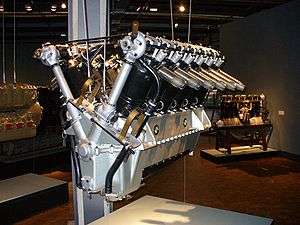BMW VI
| BMW VI | |
|---|---|
 | |
| BMW VI at the Technik-Museum Berlin | |
| Type | V engine |
| Manufacturer | BMW |
| First run | 1926 |
| Developed from | BMW IV |
| Developed into | BMW VII, BMW IX |
The BMW VI was a water-cooled V-12 aircraft engine built in Germany in the 1920s. It was one of the most important German aero engines in the years leading up to World War II, with thousands built. It was further developed as the BMW VII and BMW IX, although these saw considerably less use. It was also produced in the Soviet Union and Japan as the Kawasaki Ha-9.
Design and development
The BMW VI was the first twelve-cylinder engine built by the BMW. It essentially consisted of two cylinder banks from the six-cylinder BMW IV bolted to a common cast aluminium crankcase at a 60-degree included angle between the cylinder banks. Series production commenced in 1926 after type approval had been granted. From 1930 on, after 1000 engines of the BMW VI type had already been delivered, Germany was again permitted to construct military aircraft. The sudden additional demand resulted in the production figures increasing rapidly. In 1933 the BMW VI was used for BMW's first experiments with direct fuel injection.
The BMW VI was the chosen source of power for numerous record-breaking and long-distance flights, including an east-to-west crossing of the Atlantic in 1930 and a round-the world flight in 1932, both by Wolfgang von Gronau in an open Dornier Wal flying boat powered by two BMW VI engines.
The BMW VI was put to unusual use as a power unit for the "Rail Zeppelin" high-speed railcar. Many versions of the BMW VI engine were developed, and it was built under license in Japan and the Soviet Union. This was further evidence of the reliability of an engine with which BMW made a fundamental contribution to the build-up of German air transport. At least 9,200 were built between 1926 and 1938. The engine was license-built in the Soviet Union under the supervision of Mikulin, who then further developed it as the M-17. More license built engines were produced by Kawasaki Heavy Industries in Japan as the Kawasaki Ha-9.
Applications
Specifications (BMW VI)

Data from de:BMW VI
General characteristics
- Type: V-12
- Bore: 160 mm (6.30 in)
- Stroke: 190 mm (7.48 in)/199 mm (7.83 in) different between right and left cylinder bank due to articulated connecting rods.
- Displacement: 46.93 L (2,864 cu in)
- Length: 1,810 mm (71.26 in)
- Width: 859 mm (33.82 in)
- Height: 1,103 mm (43.43 in)
- Dry weight: 510 kg (1,124 lb)
Components
- Fuel system: 2 x Zenith 60 DCL
- Fuel type: min. 87 octane gasoline
- Cooling system: Liquid-cooled
Performance
- Power output: 480 kW (650 hp)
- Compression ratio: 5.50
See also
- Related development
- Comparable engines
- Related lists
References
- Gunston, Bill (1986). World Encyclopedia of Aero Engines. Wellingborough: Patrick Stephens. p. 25.
External links
| Wikimedia Commons has media related to BMW VI. |